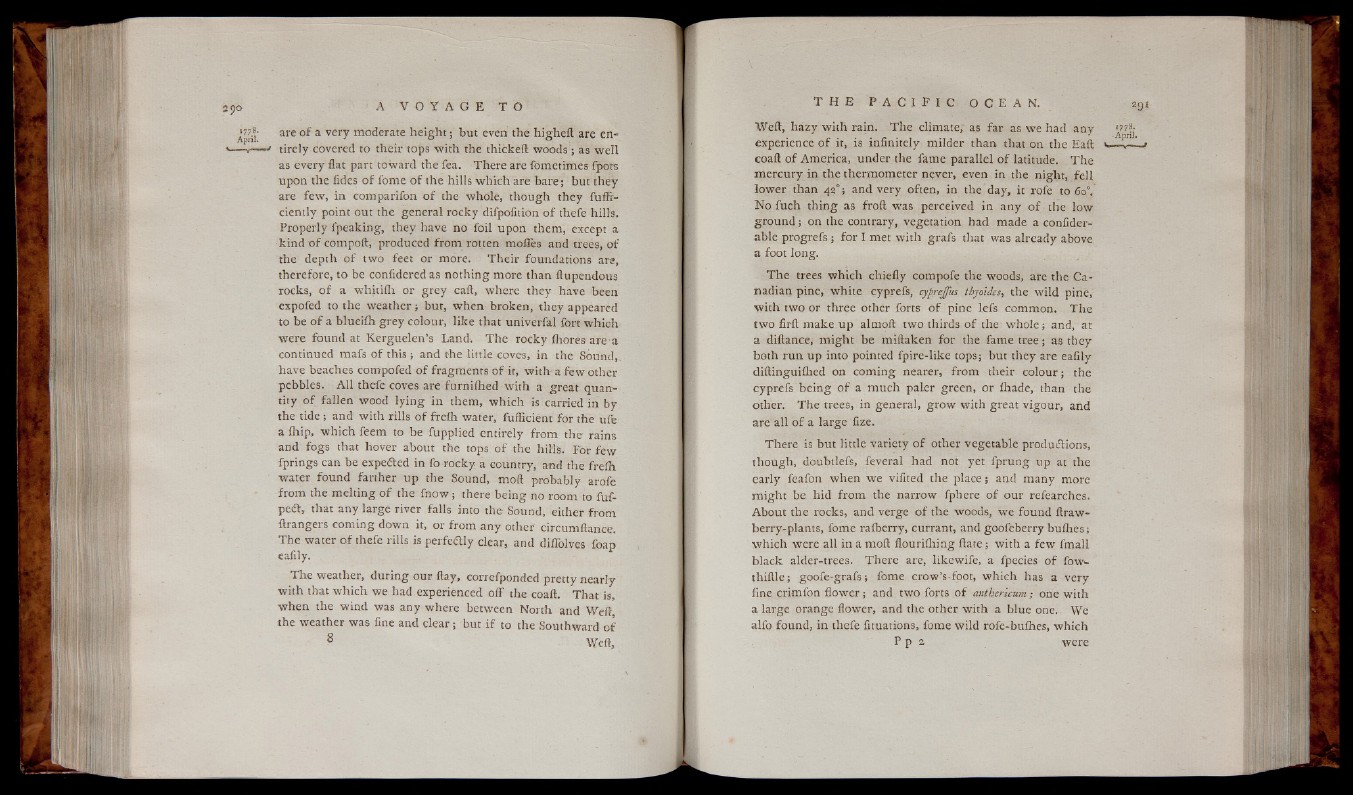
are o f a very moderate h e ig h t ; but even the higheft are entirely
covered to their tops with the thickeft woods ; as w e ll
as every flat part toward the fea. There are fometimes fpors
upon the fides o f fome o f the hills which are bare; but they
are few , in comparifon o f the whole, though they fuflr-
ciently point out the general rocky difpofition o f thefe hills.
Properly fpeaking, they have no foil upon them, except a
kind o f compoft, produced from rotten mofles and trees, o f
the depth o f two feet or more. T h e ir foundations are,
therefore, to be confidered as nothing more than flupendous
rocks, o f a whitiih or g re y call, where they have been
expofed to the w e a th e r ; but, when broken, th e y appeared
to be o f a blueiflx g re y colour, lik e that univerfal fort which
were found at Kerguelen’s Land. T he rocky Chores are a
continued mafs o f this ; and the little coves, in the Sound,,
have beaches compofed o f fragments o f ir, w ith a few other
pebbles. A ll thefe coves are furniihed with a great quantity
o f fallen wood ly in g in them, w h ich is carried in by
the t id e ; and with rills o f frefli water, fufficient for the ufe
a ihip, w h ich feem to be fupplied entirely from the rains
and fogs that hover about the tops o f the hills. For few
fprings can be expedled in fo rocky- a country, and the frefh
water found farther up the Sound, mod probably arofe
from the melting o f the fn ow ; there being no room to fuf-
p e d , that any large river falls into the Sound, either from
ftrangers coming down it, or from any other circumftance.
T he water o f thefe rills is perfectly clear, and diflolves foap
eafily.
T he weather, during our flay, correfponded pretty nearly
w ith that w hich we had experienced o ff the coaft. That is,
w hen the wind was any where between North and Weft
the weather was fine and c le a r ; but i f to the Southward o f
8 Weft,
Weft, ha zy with rain. T h e climate; as far as we had any
experience o f it, is infinitely milder than that on the Eaft
coaft o f America, under the fame parallel o f latitude. T h e
me rcury in the thermometer never, even in the night, fe ll
lower than 43°; and very often, in the day, it rofe to 60°.
No fuch thing as froft was perceived in any o f the low
g ro u n d ; on the contrary, vegetation had made a confider-
able p ro g re fs ; for I met w ith grafs that was already above
a foot long.
T h e trees w hich chiefly compofe the woods, are the C a nadian
pine, white cyprefs, cypreffus thyoides, the wild pine,
with two or three other forts o f pine lefs common. T h e
two firft make up almoft two thirds o f the w ho le; and, at
a diftance, migh t be miftaken for the fame tre e ; as they
both run up into pointed fpire-like tops; but they are eafily
diftinguiihed on coming nearer, from their co lo u r ; the
cyprefs be in g o f a much paler green, or lhade, than the
other. T he trees, in general, g row with great vigour, and
are all o f a large fize.
There is but little variety o f other vegetable productions,
though, doubtlefs, feveral had not yet fprung up at the
early feafon when we vifited the p la c e ; and many more
might be hid from the narrow fphere o f our refearches.
About the rocks, and verge o f the woods, we found ftraw-
berry-plants, fome raiberry, currant, and goofeberry buflies;
w h ich were all in a moft flourifliing ftate ; with a few fmall
b la ck alder-trees. There are, likewife, a fpecies o f fow-
thiftle; goofe-grafs; fome crow’s-foot, which has a very
fine crimfon flower ; and two forts o f anthericum; one with
a large orange flower, and the other with a blue one., We
alfo found, in thefe fituations, fome wild rofe-buihes, which
P p 2 were